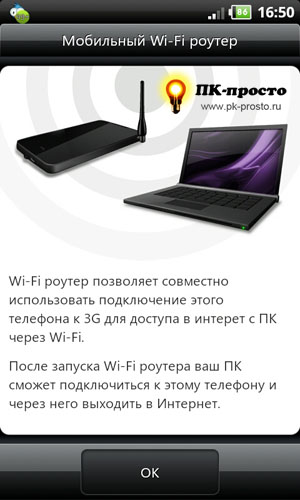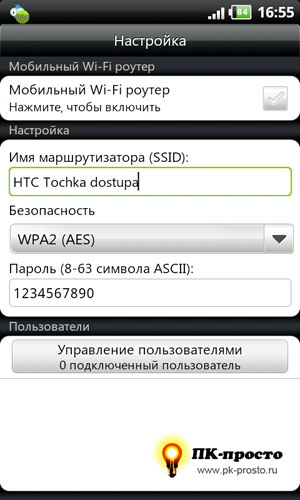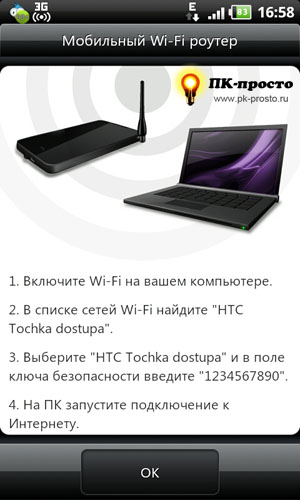Read an easy way to make your Android smartphone work as an access point. Using an Android smartphone, you can distribute Internet traffic to tablets and laptops. In this article, we will tell you how to turn your smartphone into a Wi-Fi distribution source.
Smartphone on Android as an access point
Wi-Fi in public places is becoming more and more common, but from time to time we find ourselves in situations where the Internet is needed, but there is no distribution source at hand. Fortunately, you can turn on the hotspot on your smartphone to access the Internet from other devices.
In this case, the smartphone easily replaces the portable wifi router, which costs a lot and is used less often.
Why might you want to use your phone as a Wi-Fi hotspot?
When using your phone as an access point to access the Internet (this phenomenon is also sometimes called teasing), it does not hurt to pay attention to the amount of traffic consumed. If to smartphone wifi many devices will be connected, the Internet traffic package can “deflate” very quickly.
To track the volume of used mobile traffic, go to the "Settings" of your gadget. Click on "Data Transfer". It will not be superfluous to set a limit if unlimited Internet is not connected.
We distribute Wi-Fi Internet from an Android smartphone
Open "Settings" and under the section "Wireless networks" we find the line "More"
The first time you have to tinker a little with the settings, which we do - go to "Access Point Settings"
We enter or rename the network name, set a password, which must consist of at least 8 characters. After that click "Save"
Move the switch position near the line "Wi-Fi access point" to the on position
Now the Wi-Fi hotspot is turned on, so that your friends can use it, you need to tell them your username and password. You can then connect on other devices to Wi-Fi just like you would to any other wireless network.
And do not forget that when distributing Wi-Fi through a smartphone, not only the amount of traffic consumed increases, but also the load on the battery. For more economical charging consumption, you should turn off the Wi-Fi access point in the settings when it is not needed
There are times when the phone cannot be configured as an access point. This is usually associated with old version Android. In this case, you can also distribute the Internet to a laptop or computer, but you will need a usb cable.
One of the main trends today is the release of tablets, the only way to access the Internet for which is a wireless interface (Wi-Fi). Of course, this is convenient - if there is an access point nearby that you can use. But what if you find yourself far from civilization? If there is no access point nearby, tablets, and with them consoles, laptops and electronic readers, lose the lion's share of their own functionality. You can solve this problem - almost any modern smartphone can be easily reconfigured into a Wi-Fi access point.
Such technology will come to your aid if you are in a place where a full-fledged wired connection no, like a full wireless router. For example, you can use it while staying outside the city. The only thing to worry about in advance is to secure cheap - and, best of all, unlimited - mobile data, because in essence you will turn your smartphone into a kind of gateway between 3G and Wi-Fi Internet.
So, in this article you will find the answer to the question of how to make Android devices Wi-Fi hotspot.
First of all, it should be noted that all gadgets that are running Android 2.2 and later have a Wi-Fi hotspot function, so you do not need to download any additional applications. All you have to do is follow the steps below.
Go to the "Settings" menu on your smartphone and select the "Advanced" option in it.
Further actions depend on which phone model and manufacturer you are going to turn into a Wi-Fi hotspot. You will need to find the "Portable Wi-Fi hotspot" option. Most likely, it will be located in the "Wireless networks" or "Tethering and access point" submenu. Once you have found the Portable Wi-Fi Hotspot option, check it and open the Hotspot Settings submenu. This submenu allows you to configure the wireless settings. After that, the wireless network will be configured, and you can connect your laptop or tablet to it without any problems.
As for gadgets that run on earlier versions of Android, in order to turn them into a Wi-Fi hotspot, you will need to install some of the programs necessary for this purpose in advance. If you have Root permissions, then you can use WiFi program Tether for Root Users or WiFi Tethering app. If you do not have Root access rights, then you can use the WiFi HotSpot or FoxFi applications. They have slightly fewer features, but this is redeemed by not having to root the phone.
At using android devices as a Wi-Fi hotspot, up to five other devices can access the world wide web using your phone at the same time.
Today, many people can no longer imagine their lives without the Internet. Often we use the so-called "mobile Internet", which is getting cheaper every day. A huge number of phones and smartphones support the 3G standard, and some models can already work in 4G networks, giving us even more speed. So how can we harness the internet potential of our smartphones?
Firstly, a smartphone used as an Internet access point replaces a 3G modem, which is usually programmed for a specific mobile operator. This means that without unlocking the modem, you will not be able to use the SIM card of another operator in it. in this situation, you can use a universal 3G modem, but if you already have a smartphone, you do not have to spend money on a modem separately. In addition, some models of communicators support two or even three SIM cards at once, which no modem can boast of. Secondly, a communicator as an access point can help you save money if connecting to other wireless or wired communication networks is paid (for example: airport or train station, hotel, conference room).
Thirdly, the distribution of mobile Internet from the phone can be very relevant if the speed and security of other networks leave much to be desired (an example could be this situation: one open Wi-Fi network is available, to which many devices are already connected and on which there are restrictions on traffic bandwidth).
From a technical point of view, everything is arranged like this: a smartphone establishes an Internet connection through the operator's network and provides access to other devices - for example, a laptop, tablet or another phone. The communicator itself includes a DHCP server function and provides access through NAT.
Equipment that requires network access can connect to a smartphone via USB, Wi-Fi or Bluetooth. In the case of Wi-Fi and Bluetooth, a virtual network will be created, which it is recommended to protect with a password.
Setting
We will create an access point to the Internet through a communicator on operating system Android. This mobile OS is quite common in our time and has a number of useful applications for our purposes. For the experiment, I will use my HTC Desire communicator with Android 2.3.3 on board.
Starting from version 2.2, the Internet sharing mode is officially supported by the system and works for USB and Wi-Fi. Let's get started with the setup.
Launch the application WiFi router and after reading the greeting press OK .


Now check the box Click to enable , and if you did everything correctly, you will see a small instruction on what needs to be done on the computer in order to connect to the network. We perform all the operations one by one and now you are already on the Internet.

If for some reason you cannot set up a connection through a standard application or you lack some settings, you can use third-party software, such as Open Garden Wi-Fi Tether.
It is worth mentioning that the access point configured via a smartphone operates exclusively in ad-hoc mode, and not in the “infrastructure” mode that regular Wi-Fi access points use. Therefore, only computers, tablets and some mobile devices that support ad-hoc connectivity.
The disadvantage of distributing the Internet over Wi-Fi is that the battery runs out very quickly. This problem is solved quite simply: put the phone on charge.
A tablet based on the Android system usually has 2 interfaces - wireless Wi-Fi and a mobile GSM / 3G modem. On a tablet that does not have a built-in GSM / 3G modem, you can create a similar access point if the device supports USB-host mode and is able to connect to the World Wide Web using an external USB module. Access to the worldwide network via Wi-Fi can be distributed to several devices at once. This is a fairly convenient procedure used on vacation in places remote from urban civilization.
To distribute the Internet via Wi-Fi using a tablet, you must first connect the device to a 3G network, for which you should enter the "Menu", select "Advanced settings" and check the "Mobile networks" option. To make a router out of a tablet, you need to go to the "Modem and access point" section, where you can activate the corresponding module. Next, in the menu that opens, select the desired wifi network and enter the password to connect to it.
This method is convenient to use when you need to connect a number of devices to the network. Important condition for this access - unlimited tariff.
Features of converting a tablet computer into a Wi-Fi access point
Knowing how to make a wifi access point from a tablet, you can turn Tablet PC to a Wi-Fi hotspot to connect multiple devices to the worldwide network at once. To do this, in the Settings you need to select the "Wireless devices" section. After marking the Wi-Fi access point, you should click the "Wi-Fi Setup" option to set the network name. Then you should configure the security settings by entering, for example, a password. Password to mobile Internet can be found in the instructions in the text about portable hotspot.
The activated SIM card must be inserted into the tablet, which will independently decide what to do with it. By enabling the "Data transfer" option in the "Settings", the Internet will be automatically configured (the operator himself solves any problems).
Related videos:
Other related news:
Viewed: 2 830 times
__________ _____________ __________ ______ ____ ______ ______________ __________ ________ ______ ________ _____ ________ _______ _____ _________ ____ ______ _____ ______ ___ __________ ____ _______ ______ ______ ______ ________ ______ ____ ________ ____ ________ _______ ______
